ISSN ONLINE(2278-8875) PRINT (2320-3765)
ISSN ONLINE(2278-8875) PRINT (2320-3765)
Ankit Jindal1, Charanjeet Singh2, Dharam Vir3
|
| Related article at Pubmed, Scholar Google |
Visit for more related articles at International Journal of Advanced Research in Electrical, Electronics and Instrumentation Engineering
MANET is a mobile ad hoc network in which nodes are move freely and perform the communication. In mobile ad hoc network, directional antenna plays a vital role. Directional antenna has many advantages such as increased transmission range, higher gain and reduced interference. Directional antenna uses a set of elements which has fixed beam nature and radiate the frequency in all directions and also at a specific angle. In this paper we analyze the performance of different directional antennas for different routing protocols such as AODV, LANMAR and RIP. The performance analysis is based on different metrics of the application layer such as average jitter, average end to end delay and the basis of physical layer metrics such as power consumed in transmit, receive and idle mode using QualNet 6.1.
Keywords |
| AODV, MANET, AODV, RIP, LANMAR, Directional Antenna, QualNet 6.1. |
INTRODUCTION |
| Directional antenna [8] can radiate the frequency in all directions and also provide the great area of coverage and reduction in power consumption. With these features directional antenna has been used in mobile ad hoc network. MANET is a network without infrastructure. Mobile ad hoc network has a new structure in the field of communication network. They do not require any fixed infrastructure for instance a base station to work. The nodes change address topology themselves due to the mobility, the entrance or exit of nodes. These nodes use a radio medium [7] [9]. In the infrastructure less networks the nodes can freely move within the range but in an infrastructure mode all the nodes are stationary. Due to the mobility of nodes and increasing number of nodes/users, the transformation of information will consume most of the bandwidth. To transmit the data [7] from one node to another node we use different types of protocols such as reactive, proactive and hybrid. |
| This paper is organized as follows: Section II presents the Related work done so far. Section III presents the description of routing protocols. Section IV represents the classification of directional antenna. Section V represents the method which is used. Section VI shows the Result and Discussion. |
LITEARTURE SURVEY |
| The directional antenna offers the many benefit such as increases the spatial reuse, coverage range and network capacity. But it also increases the hidden terminal problems and the deafness problems. In this paper, author propose a MAC protocol with directional antenna in which proposed algorithm is based in a circular directional RTS(ready to send) and scans the area around the transmitter and informing the neighbours for the communication. Through the use of this technique, the hidden terminal problem is strongly decreases [1]. |
| The author propose the use of directional antenna for improving the efficiency of on-demand protocols and introduce the technique for saving the wireless bandwidth in the on demand routing and shows how the directional antenna can be effectively used to estimate the direction of a destination node from the source node and restrict the search for a new route with in the vicinity of the estimated direction [10] |
| Higher throughput gain and prolonged life time can be achieved for MANET with nodes equipped with directional antenna. The author represent the power control scheme for directional MAC protocols and derived the temporal transmission power correlation between the MAC protocols packets (RTS/CTS/DATA/ACK) for successful communication and avoid the hidden terminal problems, deafness and side lobe interference. The simulation results show that the power control scheme is sufficient and efficient in terms of throughput and energy consumption. [6]. |
ROUTING PROTOCOLS |
| AODV: It stands for Ad hoc On Demand Distance Vector routing protocol. AODV protocol is specially used for mobile ad hoc networks and provides a quick adaptation to dynamic link condition, link fault, low processing and memory usage overhead [13]. AODV allows mobile nodes to obtain routes quickly for new destinations, and does not require nodes to maintain routes to destinations that are not in active communication. It supports both IPv4 and IPv6. When a node i.e. source node is ready for communication and does not have a valid route to the destination then it performs two operations namely, route discovery and route maintenance [5]. |
| Route discovery: As the name suggest, to transmit the data a new route is discovered. To find a new route, AODV proceeds by broadcasting the route request (RREQ) packet. If the neighbouring nodes which receives the RREQ has no route information regarding the destination, it will continue to broadcast RREQ packet in the network. Once the destination is found, it will send an answer key by the route reply (RREP) packet to the sender from which RREQ is received. When the RREP is received at the source node, the path is established. RREQ contains source address, source sequence number, broadcast id, destination address, destination sequence number and hop count [5]. |
| Route maintenance: It is the next step which is followed by the AODV protocol after route discovery. In this step, it finds the error which comes during transmission like if the two nodes that were listed as neighbour on the route moved out of the range of each other and link is broken [5] and then source node is informed with a ROUTE ERROR packet and then again route discovery mechanism is used to find a route. |
| LANMAR: It stands for Land Mark Ad hoc Routing protocol. It uses the concept of landmark to provide the route in large, mobile and ad hoc network. FISHEY is used by the LANMAR as a local scope routing protocol. It also uses the distance vector routing for landmark updates[12]. The QualNet LANMAR model is based on the draft-ietf-manetlanmar- 04[12]. |
| RIP: It stands for Routing Information Protocol. RIP is also called a hybrid protocol since it has the features of both reactive and proactive protocol. This protocol is based on the phenomena of BELLMON-FORD or the distance vector algorithm. RIP (routing information protocol) makes the routing decisions based on the hop count between a router and a destination. RIP provides the route between nodes based on the destination address. In a network a router is able to look at a packet destination address and then analyze which output port is best to receive the packet to that address. The router obtains this information by using forwarding table [12] [9]. |
CLASSIFICATION OF ANTENNAS |
| 1) Omni directional |
| 2) Steerable |
| 3) Switched Beam |
| 1) Omni directional: An Omni directional antenna is used to avoid the co-channel interference. It is a device which radiates/receives the electromagnetic energy in all directions. Direction antenna is also known as smart antenna that consists of number of radiating elements as well as control unit which is implemented by the digital signal processor. When a network is closely packed with a large number of nodes then the transmission range of each node is collapsed with others. Due to this collapsing of range, nodes face the co-channel interference during transmission. The number of packet drops increases and hence the network performance decreases. Routing algorithms of Omni directional antennas and fixed transmission power have an upper bound to the number of intermediate hops between a pair of source and destination. To overcome this problem the Omni directional antenna focus the beam at narrow angles and radiate the energy in all direction [8] [7]. |
| 2) Steerable antenna: Steerable antenna is also a type of directional antenna which is used to reduce the interference. In a network, when the source nodes cannot focus to a specific angle of the receiver node, a steerable antenna has capability to do this. Steerable antenna consists of all types of antenna elements in such a manner that the beam is directed towards the receiver node at a specific angle. The antenna elements are placed in such a way that main lobe, side lobe and tail lobe do not create interference and hence interference is reduced [8] [7]. |
| 3) Switched beam: Switch beam antenna is a smart directional antenna. It is simpler and cheaper than steerable antenna. It uses a radio frequency that combines the antenna elements. These antenna elements divide the network in equal sectors and antenna elements emit the fixed beam that covers one sector. In network when the nodes are moved then switched beam antenna propagates the fixed beam and provide the better performance. Switch beam antenna base station selects the beam that supports the maximum signal to interference and noise ratio. The main disadvantage of switch beam antenna is its fixed nature due to which it cannot focus at a specific angle [8] [7] [12]. |
SIMULATION SETUP |
Simulation scenario: |
| In this paper we used the QualNet 6.1 simulator [7] which is developed by the Scalable Network Technologies. In this paper we use the terrain size 1500X1500 m2, number of nodes is 40, CBR of packet size is 1024, the simulation time is 40 sec, energy model is MICAZ, MAC protocol 802.11, mobility model is random way point and battery model is residual life estimator with charging interval-60. It analyzes the performance of AODV, LANMAR and RIP protocols using different Directional antennas. |
 |
| Table 1 Parameter Table |
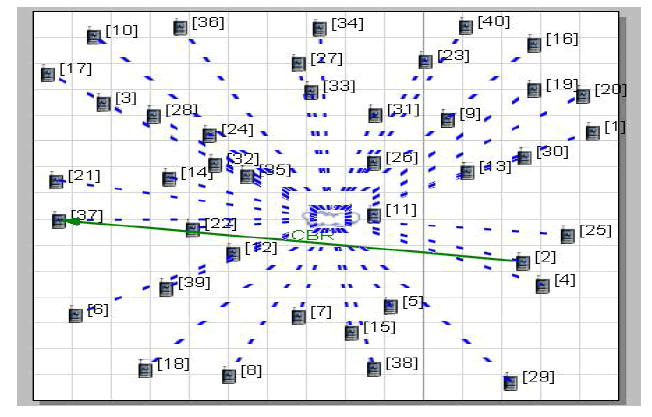 |
| Fig. 1 Snapshot of QualNet Animator in action applying AODV routing protocol using 40 nodes. |
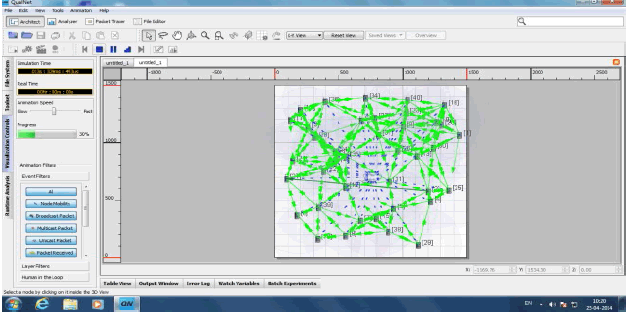 |
| Fig.2 Simulation snapshot of QualNet Animator in action applying LANMAR routing protocol using 40 nodes. |
RESULT AND DISCUSSION |
A) Throughput: |
| It is the phenomena from which we calculate the average rate of successful data packet from received at destination. It is measured in bits second, sometimes in data packet per second. The RIP presents highest values of THROUGPUT for Omni and Steerable antennas. The AODV shows highest value of THROGHPUT for Switched beam antenna. So, AODV is best suited for switched beam and RIP for Omni and steerable to receive maximum data rate successfully. |
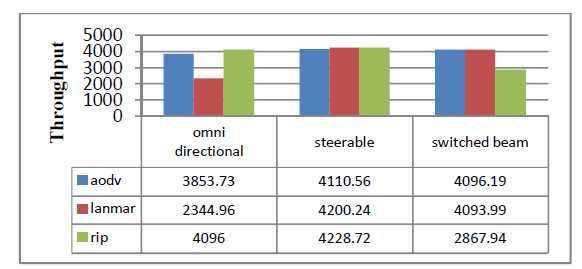 |
| Fig 3 shows the impact variation of throughput for various routing protocol using different directional antenna |
| B) End to End Delay: It is the phenomena from which we calculate the difference between send time and receive time when data send from source to destination node. It is measure in seconds. The AODV presents highest values of End to End Delay for Omni, switched beam and steerable antennas. The RIP presents least value of End to End Delay for all three directional antennas. Therefore, RIP shows fast reception of data packets as compared to AODV. |
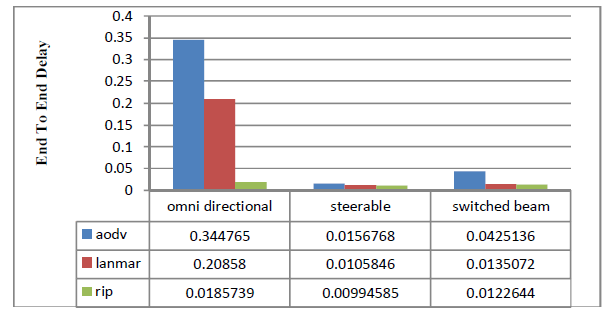 |
| Fig.4 shows the impact variation of End to End Delay for various routing protocol using different directional antenna |
B) Average Jitter: |
| Jitter is termed as the variation in packet delay. It shows the variation of time taken by different data packets when move from source to destination. The AODV presents highest values of Average Jitter for all three antennas. The RIP presents least value of the average jitter for all three directional antennas. Hence, RIP saves the more time as compared to AODV. |
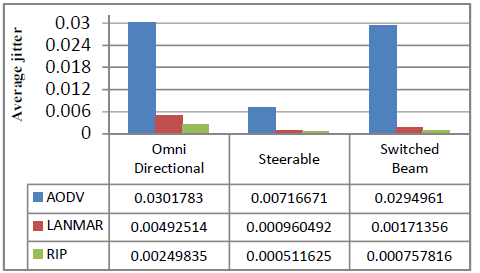 |
| Fig. 5 shows the impact variation of average jitter for various routing protocol using different directional antenna |
E) Energy consumed in Transmit Mode: |
| It is the form of energy which is use to send or transmit the data packets from a node to another node. This energy depends upon the size of data packet. When the size of packet increases then it require large amount of energy to transmit packet. The LANMAR consumes highest energy in all directional antennas. The AODV consumes least energy for all three antennas. So we can conclude that AODV is best fitted for most energy saving for all antennas in transmit mode. |
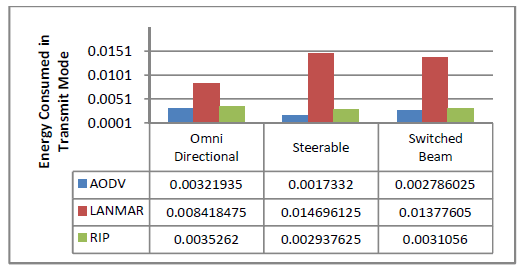 |
| Fig. 6 shows the impact variation of energy consumed in transmit mode for various routing protocol using different directional antenna |
F) Energy Consumed in Receive Mode: |
| It is the form of energy which is used to receive the data packets from another node. The energy used to receive packet is known as energy consumed in receive mode. The LANMAR presents highest energy consumed in all directional antennas. The AODV consumes least energy for all directional antennas. The comparative study shows AODV is the best option to save the energy to the maximum in receive mode. |
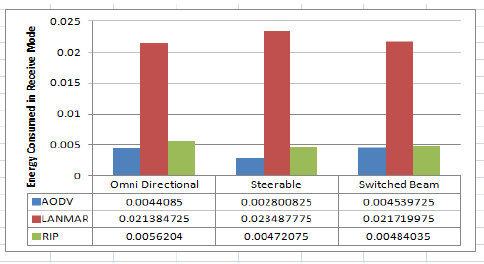 |
| Fig. 7 shows the impact variation of energy consumed in receive mode for various routing protocol using different directional antenna |
G) Energy Consumed in Idle Mode: |
| This is the form of energy which neither come in transmit nor in receive mode. In this mode we conclude that LANMAR consumes lowest energy for all directional antennas which consumed the highest energy for both transmit and receive mode. RIP consumes moderate energy for all three directional antennas in all the three modes. Whereas AODV saves least amount of energy in idle mode. |
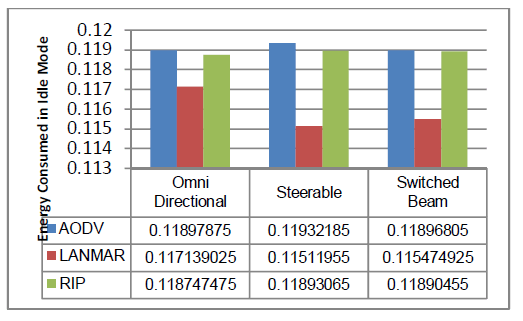 |
| Fig. 8 shows the impact variation of energy consumed in idle mode for various routing protocol using different directional |
CONCLUSION |
| Finally we plotted the graphical representation of comparison between different protocols (RIP, LANMAR and AODV) using different types of Directional antennas (Omni Directional, Steerable and Switched Beam). During simulation we analyze different parameters such as Throughput, Average Jitter and End to End Delay for physical layer and Energy consumed in Transmit, Receive and Idle mode for application layer. Finally we conclude that AODV provides highest values for Average Jitter and End to End Delay as compared to RIP which degrades the system performance but in application layer AODV consume less energy as compared to LANMAR. |
References |
|